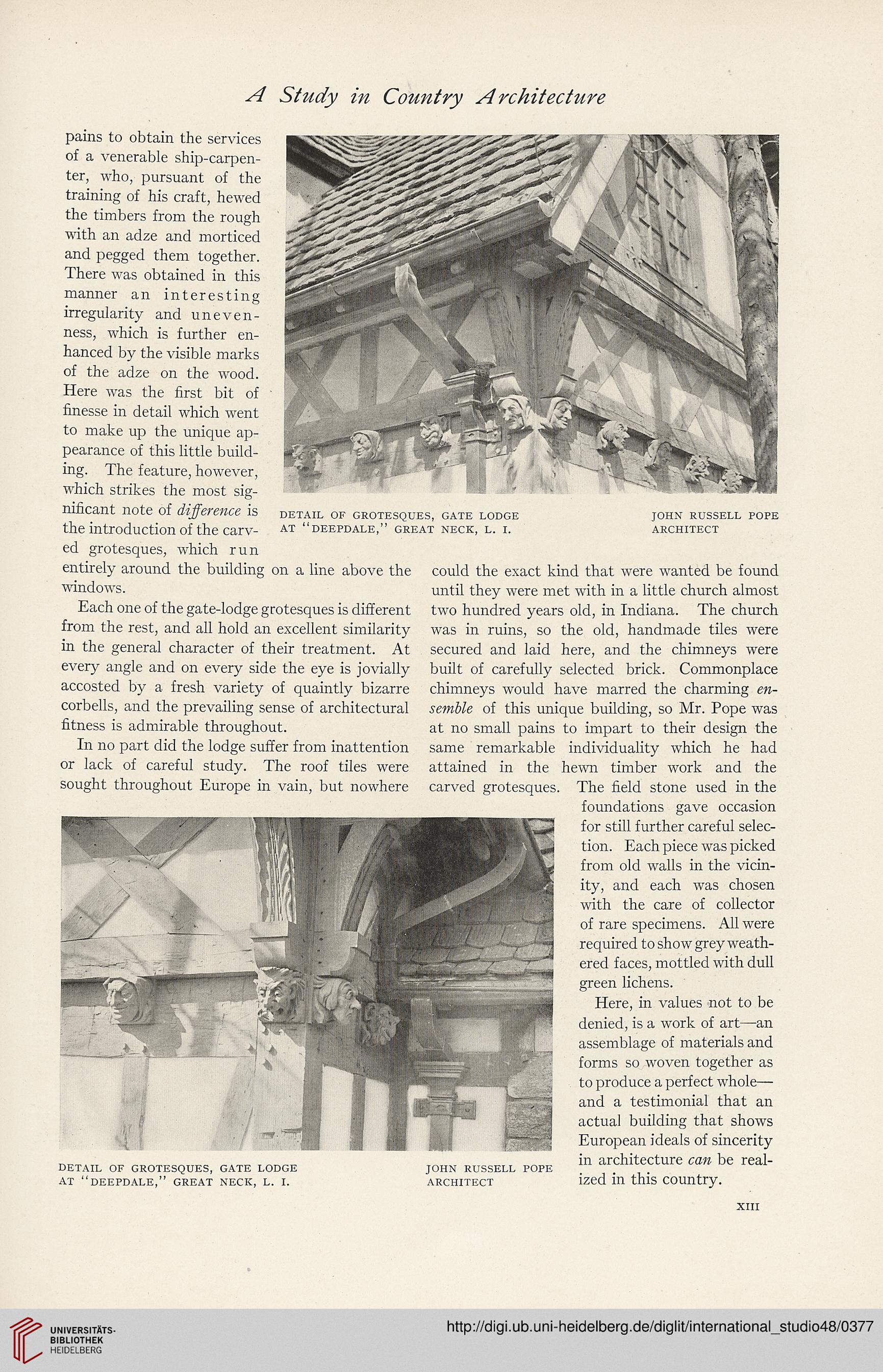A Study in Country Architecture
pains to obtain the services
of a venerable ship-carpen-
ter, who, pursuant of the
training of his craft, hewed
the timbers from the rough
with an adze and morticed
and pegged them together.
There was obtained in this
manner an interesting
irregularity and uneven-
ness, which is further en-
hanced by the visible marks
of the adze on the wood.
Here was the first bit of
finesse in detail which went
to make up the unique ap-
pearance of this little build-
ing. The feature, however,
which strikes the most sig-
nificant note of difference is
the introduction of the carv-
DETAIL OF GROTESQUES, GATE LODGE
AT “DEEPDALE,” GREAT NECK, L. I.
JOHN RUSSELL POPE
ARCHITECT
ed grotesques, which run
entirely around the building on a line above the
windows.
Each one of the gate-lodge grotesques is different
from the rest, and all hold an excellent similarity
in the general character of their treatment. At
every angle and on every side the eye is jovially
accosted by a fresh variety of quaintly bizarre
corbells, and the prevailing sense of architectural
fitness is admirable throughout.
In no part did the lodge suffer from inattention
or lack of careful study. The roof tiles were
sought throughout Europe in vain, but nowhere
DETAIL OF GROTESQUES, GATE LODGE
AT “DEEPDALE,” GREAT NECK, L. I.
could the exact kind that were wanted be found
until they were met with in a little church almost
two hundred years old, in Indiana. The church
was in ruins, so the old, handmade tiles were
secured and laid here, and the chimneys were
built of carefully selected brick. Commonplace
chimneys would have marred the charming en-
semble of this unique building, so Mr. Pope was
at no small pains to impart to their design the
same remarkable individuality which he had
attained in the hewn timber work and the
The field stone used in the
foundations gave occasion
for still further careful selec-
tion. Each piece was picked
from old walls in the vicin-
ity, and each was chosen
with the care of collector
of rare specimens. All were
required to show grey weath-
ered faces, mottled with dull
green lichens.
Here, in values not to be
denied, is a work of art—an
assemblage of materials and
forms so woven together as
to produce a perfect whole—
and a testimonial that an
actual building that shows
European ideals of sincerity
in architecture can be real-
ized in this country.
carved grotesques.
JOHN RUSSELL POPE
ARCHITECT
XIII
pains to obtain the services
of a venerable ship-carpen-
ter, who, pursuant of the
training of his craft, hewed
the timbers from the rough
with an adze and morticed
and pegged them together.
There was obtained in this
manner an interesting
irregularity and uneven-
ness, which is further en-
hanced by the visible marks
of the adze on the wood.
Here was the first bit of
finesse in detail which went
to make up the unique ap-
pearance of this little build-
ing. The feature, however,
which strikes the most sig-
nificant note of difference is
the introduction of the carv-
DETAIL OF GROTESQUES, GATE LODGE
AT “DEEPDALE,” GREAT NECK, L. I.
JOHN RUSSELL POPE
ARCHITECT
ed grotesques, which run
entirely around the building on a line above the
windows.
Each one of the gate-lodge grotesques is different
from the rest, and all hold an excellent similarity
in the general character of their treatment. At
every angle and on every side the eye is jovially
accosted by a fresh variety of quaintly bizarre
corbells, and the prevailing sense of architectural
fitness is admirable throughout.
In no part did the lodge suffer from inattention
or lack of careful study. The roof tiles were
sought throughout Europe in vain, but nowhere
DETAIL OF GROTESQUES, GATE LODGE
AT “DEEPDALE,” GREAT NECK, L. I.
could the exact kind that were wanted be found
until they were met with in a little church almost
two hundred years old, in Indiana. The church
was in ruins, so the old, handmade tiles were
secured and laid here, and the chimneys were
built of carefully selected brick. Commonplace
chimneys would have marred the charming en-
semble of this unique building, so Mr. Pope was
at no small pains to impart to their design the
same remarkable individuality which he had
attained in the hewn timber work and the
The field stone used in the
foundations gave occasion
for still further careful selec-
tion. Each piece was picked
from old walls in the vicin-
ity, and each was chosen
with the care of collector
of rare specimens. All were
required to show grey weath-
ered faces, mottled with dull
green lichens.
Here, in values not to be
denied, is a work of art—an
assemblage of materials and
forms so woven together as
to produce a perfect whole—
and a testimonial that an
actual building that shows
European ideals of sincerity
in architecture can be real-
ized in this country.
carved grotesques.
JOHN RUSSELL POPE
ARCHITECT
XIII




